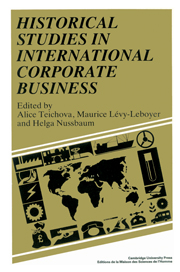Book contents
- Frontmatter
- Contents
- Preface
- 1 Introduction: multinational enterprise
- 2 History, the social sciences and economic ‘theory’, with special reference to multinational enterprise
- 3 The changing form of multinational enterprise expansion in the twentieth century
- 4 Electrical research, standardisation and the beginnings of the corporate economy
- 5 The nature of multinationals, 1870–1939
- 6 International price maintenance: control of commodity trade in the 1920s
- 7 Financial operations of US transnational corporations: development after the Second World War and recent tendencies
- 8 Multinational enterprise – financing, trade, diplomacy: the Swedish case
- 9 Foreign penetration of German enterprises after the First World War: the problem of Überfremdung
- 10 International industrial cartels, the state and politics: Great Britain between the wars
- 11 Vickers and Schneider: a comparison of new British and French multinational strategies 1916–26
- 12 J. & P. Coats Ltd in Poland
- 13 Multinationals and the French electrical industry, 1889–1940
- 14 The Japanese cotton spinners' direct investments into China before the Second World War
- 15 Mitsui Bussan during the 1920s
- 16 Japanese business in the United States before the Second World War: the case of Mitsui and Mitsubishi
- 17 The state and private enterprise in the United States–Latin American oil policy
- 18 Transnational corporations and the denationalization of the Latin American cigarette industry
- 19 Summary: Reflections on the papers and the debate on multinational enterprise: international finance, markets and governments in the twentieth century
- Index of names
- Index of firms
- Index of subjects
14 - The Japanese cotton spinners' direct investments into China before the Second World War
Published online by Cambridge University Press: 04 August 2010
- Frontmatter
- Contents
- Preface
- 1 Introduction: multinational enterprise
- 2 History, the social sciences and economic ‘theory’, with special reference to multinational enterprise
- 3 The changing form of multinational enterprise expansion in the twentieth century
- 4 Electrical research, standardisation and the beginnings of the corporate economy
- 5 The nature of multinationals, 1870–1939
- 6 International price maintenance: control of commodity trade in the 1920s
- 7 Financial operations of US transnational corporations: development after the Second World War and recent tendencies
- 8 Multinational enterprise – financing, trade, diplomacy: the Swedish case
- 9 Foreign penetration of German enterprises after the First World War: the problem of Überfremdung
- 10 International industrial cartels, the state and politics: Great Britain between the wars
- 11 Vickers and Schneider: a comparison of new British and French multinational strategies 1916–26
- 12 J. & P. Coats Ltd in Poland
- 13 Multinationals and the French electrical industry, 1889–1940
- 14 The Japanese cotton spinners' direct investments into China before the Second World War
- 15 Mitsui Bussan during the 1920s
- 16 Japanese business in the United States before the Second World War: the case of Mitsui and Mitsubishi
- 17 The state and private enterprise in the United States–Latin American oil policy
- 18 Transnational corporations and the denationalization of the Latin American cigarette industry
- 19 Summary: Reflections on the papers and the debate on multinational enterprise: international finance, markets and governments in the twentieth century
- Index of names
- Index of firms
- Index of subjects
Summary
Introduction
The Japanese cotton industry depended heavily on overseas markets for its growth since the beginning of its development. Japanese major cotton spinners exported about 40% of their total sales in 1914. The exports of Japanese cotton spinners were almost completely confined to the Chinese market before the First World War. They had established a dominant position there, especially in the area of cotton yarn and coarse cotton cloth. They exported 500,000 bales of cotton yarn (worth about 56.5 million yen) to China. This amounted to 55% of the total imported yarns to China in 1914. They also exported coarse cotton cloth (sheeting, drill and T-cloth) for a total of 24.7 million yen which was 57% of the total amount imported to China in 1913.
During the First World War the Chinese modern cotton industry began expansion of its production capacity on a large scale while imports from Lancashire decreased and the price of cotton goods rose considerably. Then the Chinese market became self-sufficient in the areas of coarse cotton yarns (cotton yarns of 20 count and downward) and coarse cotton cloth. Imports of cotton yarns to China decreased from 901,000 bales in 1914 to 377,000 bales in 1918. Chinese imports of sheeting and drill decreased from 3,054,000 pieces and 1,759,000 pieces respectively in 1915 to 2,268,000 pieces and 952,000 pieces in 1918.
- Type
- Chapter
- Information
- Historical Studies in International Corporate Business , pp. 151 - 162Publisher: Cambridge University PressPrint publication year: 1989

